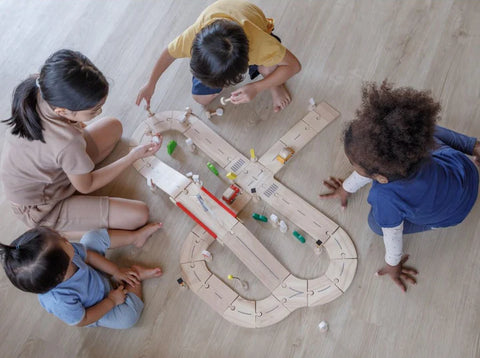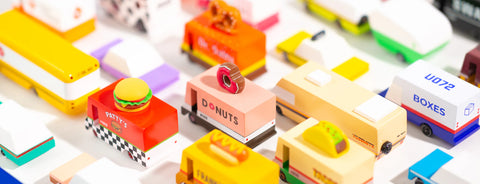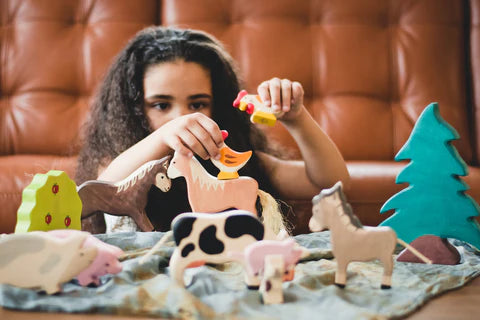
Your child’s toy box is probably full of charming wooden toys, from building blocks to carved animals! Your little one creates whimsical imaginary worlds with them, playing with them for hours. But, have you ever wondered about the story behind your child’s wood toys?
There’s more to even the simplest wood toy than meets the eye. Each toy goes on a fantastic journey to get to your child’s toybox, from forests all over the world to eco-friendly manufacturing.
Join us while we follow the journey wooden toys embark on, from trees to tots. We’ll discover why their origins matter for our little ones and the environment and shine a spotlight on brands that excel in sustainability.
1. Sustainably Sourced Wooden Toys
The journey begins with the source: the trees. Wooden toys are typically crafted from sustainably sourced wood. The trees used for making these toys are carefully chosen and replanted. This ensures a healthy and thriving forest ecosystem, contributing to the sustainability of our planet.
Some brands upcycle leftover wood material from other companies and products. When we choose brands that practice sustainable and eco-conscious sourcing practices, we’re actively creating a healthier environment for our children.

Brand Spotlight: PlanToys
When it comes to sustainably sourced wood, PlanToys excels. This brand creates countless toys to support your child’s development, from imaginative playsets to sorting toys.
To create such high-quality and beneficial toys, this brand primarily uses reclaimed rubberwood from rubber trees that no longer produce latex. They use these decommissioned trees to create solid wood and plywood.
They don’t stop there, though! PlanToys also upcycles leftover sawdust to produce PlanWood, a special material that helps them create toys with unique and dynamic shapes. Their innovative sustainability makes them a stand-out wood toy brand!
2. Carbon Neutrality
Responsible manufacturing processes mean wooden toys typically have a much smaller carbon footprint than other toys, especially plastic. They cost less energy to produce, so there are fewer harmful byproducts emitted into the environment.
Also, trees are a natural option to combat climate change. Trees absorb carbon dioxide from the atmosphere and release oxygen. When trees are harvested to create wooden toys, the carbon remains locked in the wood.
Wood is carbon-neutral choice! Plastic toys, on the other hand, are often made from fossil fuels which release carbon emissions during production.
Brand Spotlight: HABA Toys
HABA Toys makes sets the example for carbon-neutral production. They use energy-efficient production practices and work with trusted partners to ensure eco-friendly manufacturing.
This brand also regularly helps reforest local land! At their facility, they have rooftop flower beds, a pond, an orchard, and a greenhouse. They even house bird species in nesting boxes and high-bay warehouses.
3. Chemical-Free Production
Quality wooden toys produce little to no chemicals during manufacturing. Unlike plastics, harmful emissions aren’t released into the atmosphere. They don’t use fossil fuels or other unnatural materials. Check out our deep dive into why wooden toys are safer than plastic to learn more!
This also means that wooden toys are much safer for your little one. They don’t have any BPA, phthalates, cadmium, or lead. Ethical wood toy companies also always use chemical-free paints, dyes, and finishes. Everything from the solid wood to the gorgeous color is safe for both your child and the environment.
Brand Spotlight: Holztiger Wooden Animals
Holztiger takes the crown by combining chemical-free production with a gorgeous design. Their carved wooden animals and plants feature vibrant colors and personalities brought to life with non-toxic dyes and finishes.
These toys are also hand-painted! That means no byproducts are created by automated, machine painting. And, each animal or plant will be a little unique!
4. Durability and Longevity
Wooden toys leave production with the intent of lasting through years of play. Wood is more durable than plastic, being much more resistant to breakage and wear and tear. You won’t have to throw them away and replace them as often, so they stay out of landfills.
Plastic toys, unfortunately, tend to have a shorter lifespan. They break, warp, and lose color. And, they tend to be more focused on trends than on the timeless aesthetic that wooden toys aim for. Your children outgrow them faster, and they don’t have the same heirloom appeal.
Brand Spotlight: BAJO Toys
BAJO wooden toys excel in making sure their toys will last you for generations! This brand knows how important it is to save cherished toys to pass down to grandchildren, great-grandchildren, and beyond.
To help your toys last as long as possible, BAJO will replace missing pieces, fix any broken toys, and keep in touch with their customers. They focus on making their toys solid and durable to withstand a lifetime of love and play.
5. Eco-friendly Packaging
Eco-conscious business practices don’t stop once the toy leaves the production line. How toys are packaged matters just as much as where they’re sourced from and how they’re made.
Many quality wood toy brands also make an effort to make their packaging as eco-friendly as possible. You’ll find that most wood toys are packaged in biodegradable cardboard colors with non-toxic dyes.
Brand Spotlight: CandyLab Toys
For eco-friendly packaging ingenuity, CandyLab takes the cake. Their packaging is almost entirely recyclable paper and cardboard with non-toxic paints.
However, they don’t skimp on design! You’ll still love their unique packaging that’s full of personality. And, with some innovative origami and engineering, their boxes are durable and keep their wooden cars safe.

6. Open-Ended Play Benefits
Now, off the production line, you find yourself reaching for aesthetically pleasing wooden toys on the toy store shelves. Wood toys have exploded in popularity recently, and you probably love them, too. But, why?
Well, it’s more than just a trend. Natural wood toys are a timeless favorite and are resurging in popularity. In our fast-paced, overstimulating world, parents and children have been drawn to the calm simplicity of wooden toys. They’re a great way to reconnect with nature.
And, wooden toys have a lot of developmental benefits for your child. Many of them encourage open-ended play, favored in the Montessori Method. This helps your children with cognitive, social, and emotional development. Your child learns to play independently and taps into their creativity.
Many wooden toys are also created with specific developmental goals in mind. Unlike plastic toys, which appeal to overstimulating flashiness and short-lived trendiness, wooden toys engage with your child. You can choose ones to fit their age, developmental level, and more.
Brand Spotlight: PlanToys
Once again, PlanToys sets the standard for open-ended and developmentally helpful play. This brand creates toys for every age group, from as early as 0-6 months old to 3+ years old! You’ll never question the safety and appropriateness of these toys.
And, with so many unique options to choose from, there will always be something for every child. You can count on PlanToys every step of the way, whether you have a one-year-old using a push toy to help their motor skills or a three-year-old playing pretend with a kitchen set.
7. After the Toy Box
What happens to wooden toys when your little one outgrows them? We’ve already talked a bit about their longevity. They have a timeless appeal and an aesthetic that appeals to any generation. Paired with their durability, they make great family heirlooms or hand-me-downs.
If your child doesn’t feel like keeping every toy, you’ll also feel good about donating them. Because wood toys have lasting qualities, any family will enjoy them. Donation is a great way to support and give back to your community!
Even if a wooden toy does find its way into the trash, you won’t have to feel too guilty about it. Because they’re wood, they break down naturally. With no toxic paints or chemicals, they won’t release toxins into the earth when they degrade.
We’re so confident in the lifespan of wood toys that we don’t even need a brand spotlight to exemplify it! As long as the brands you choose practice quality production, you’ll have an investment that’ll last generations.
How to Choose a Quality Wood Toy
Just like any other toy on the market, not all wood toys are created equal. You want to avoid anything made with particle board, plywood, or MDF. You’ll also want to look out for chipped or unlabeled paints because they could contain toxins like lead. Avoid toys with small or flimsy parts.
We’ve shone a spotlight on some quality wooden toy brands, but there’s a lot more out there! Look for toys with safety certifications, like ASTM or CE. The best wood toy brands are transparent about their business practices, with pages on their website about their story, environmental efforts, and more.
Thrifting can also be a great way to find wood toys! However, try to identify the toy’s brands if you can. Sometimes, older products contain chemicals or toxins that weren’t well-regulated in the past.
Wooden Toys, A Sustainable Story
The journey of wooden toys, from trees to tots, is a story of sustainability, durability, and eco-conscious choices. By opting for wooden toys, we provide our children with safe and long-lasting toys and contribute to a healthier planet.
Choosing wood is a small change that makes a big difference. Every step toward a greener future matters, even in the world of play. Let's continue this journey, knowing that each wooden toy carries a piece of our planet's story and a promise for a more sustainable tomorrow.


Leave a comment